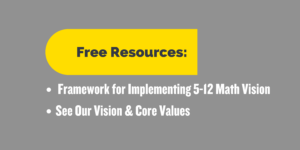Les perturbations de l'enseignement et de l'apprentissage liées à la pandémie ont affecté les élèves et les écoles du monde entier, et Uncommon Schools ne fait pas exception à la règle. À l'instar des tendances nationales, c'est en mathématiques que nos élèves ont été le plus durement touchés. Au cours des deux dernières années, nous avons saisi l'occasion de prendre du recul et de réfléchir à notre vision de l'enseignement des mathématiques, tout en restant fidèles à notre mission qui consiste à préparer tous les élèves à obtenir un diplôme universitaire et à réaliser leurs rêves.
Continuez à lire pour découvrir comment nous avons créé une vision pour l'enseignement des mathématiques de la cinquième à la douzième année, ainsi que des exemples concrets de la manière dont cette vision guide aujourd'hui les soutiens et les pratiques pédagogiques.
Un processus en trois parties pour créer une vision de l'enseignement des mathématiques de la 5e à la 12e année

Étape 1 : Examen des données
Les pertes d'apprentissage liées à la pandémie ont entraîné un changement sans précédent des méthodes d'enseignement dans de nombreuses écoles. Dans un effort pour combler rapidement les lacunes d'apprentissage, nous avons remarqué que de nombreux enseignants délaissaient l'enseignement des mathématiques conceptuelles au profit d'un enseignement des mathématiques procédurales. Cela représentait une rupture importante par rapport à nos convictions de longue date sur la valeur des mathématiques conceptuelles.
L'examen ultérieur des données relatives aux élèves a fait remonter ce défi à la surface et a prouvé qu'une approche procédurale n'était pas conforme à la rigueur de notre mission de préparation à l'université et ne contribuait pas à une compréhension profonde et durable des mathématiques. Nous savons que cela a pour conséquence que moins d'élèves poursuivent des études dans les domaines liés aux STIM et, plus important encore, que moins d'élèves développent une passion pour les mathématiques.
Nous avons dû nous poser une question difficile : pourquoi notre investissement important en temps et en efforts n'aboutissait-il pas à des résultats accélérés en mathématiques ? Confronter l'écart entre nos intentions et la réalité nous a en fait aidés à trouver une meilleure façon d'avancer.
Étape 2 : Inspection externe
 À la suite de nos réflexions internes, nous avons fait appel à une équipe de responsables pédagogiques hautement qualifiés venus du monde entier pour procéder à une inspection externe. L'équipe d'inspection a passé deux jours à visiter un certain nombre de nos écoles, à observer des classes et des moments de l'ensemble de l'école, à visionner des vidéos, à assister à des réunions de direction et à interroger des membres de l'école. À la fin de la journée, l'équipe a fourni un retour d'information approfondi sur nos pratiques culturelles et pédagogiques. L'inspection nous a permis de découvrir un autre moyen important de mieux aligner notre approche pédagogique sur notre mission : la préparation des enseignants. Pendant la pandémie, de nombreuses écoles ont vu s'aggraver les problèmes de longue date liés à la rétention des enseignants et à la pénurie d'enseignants.
À la suite de nos réflexions internes, nous avons fait appel à une équipe de responsables pédagogiques hautement qualifiés venus du monde entier pour procéder à une inspection externe. L'équipe d'inspection a passé deux jours à visiter un certain nombre de nos écoles, à observer des classes et des moments de l'ensemble de l'école, à visionner des vidéos, à assister à des réunions de direction et à interroger des membres de l'école. À la fin de la journée, l'équipe a fourni un retour d'information approfondi sur nos pratiques culturelles et pédagogiques. L'inspection nous a permis de découvrir un autre moyen important de mieux aligner notre approche pédagogique sur notre mission : la préparation des enseignants. Pendant la pandémie, de nombreuses écoles ont vu s'aggraver les problèmes de longue date liés à la rétention des enseignants et à la pénurie d'enseignants.
Nous pensons que ces problèmes de personnel ont également contribué à l'évolution vers des mathématiques procédurales. En l'absence d'un développement intentionnel, les nouveaux enseignants, en particulier ceux qui enseignaient les mathématiques pour la première fois, se sont davantage concentrés sur l'enseignement de stratégies spécifiques, en mettant par exemple trop l'accent sur les algorithmes, plutôt que sur la compréhension conceptuelle sous-jacente qui mène à une compréhension plus profonde et plus durable. Bien que l'accent mis sur des stratégies spécifiques soit la façon dont beaucoup d'entre nous ont appris les mathématiques, cette approche est limitative et peut en fait entraver l'exploration et la réflexion des élèves.
Notre inspection externe nous a aidés à comprendre qu'un retour à l'enseignement des mathématiques conceptuelles nécessiterait une formation professionnelle supplémentaire ainsi que des cadres clairement définis pour soutenir la planification et la mise en œuvre.
Étape 3 : Groupe de travail interne

Armés des résultats de notre examen des données et de notre inspection externe, nous avons formé un groupe de travail composé de 24 éducateurs aux rôles variés, de l'enseignant au chef d'établissement en passant par le responsable de l'enseignement.
Pendant la majeure partie de l'année scolaire 2022-23, notre groupe de travail a été chargé de formuler une vision de l'enseignement des mathématiques de la 5e à la 12e année qui tiendrait compte de notre mission globale et de nos les croyances sur ce que nos élèves méritent. Le groupe de travail s'est appuyé sur le livre "Leading Change" de John Kotter. L'extrait présente ici peut s'avérer une ressource utile pour toute école, tout district ou tout réseau cherchant à créer sa propre déclaration de vision.
En outre, le groupe de travail a identifié des valeurs fondamentales qui guideront la façon dont nous planifions et mettons en œuvre la préparation des enseignants, la planification des leçons et des unités, et l'enseignement au quotidien.  En outre, nous avons créé un cadre qui aiderait tous les enseignants, y compris ceux qui sont nouveaux dans la profession ou qui enseignent les mathématiques pour la première fois à Uncommon, à mettre en œuvre la vision et les valeurs fondamentales. Le cadre identifie les actions des enseignants et des élèves qui représentent une exécution réussie.
En outre, nous avons créé un cadre qui aiderait tous les enseignants, y compris ceux qui sont nouveaux dans la profession ou qui enseignent les mathématiques pour la première fois à Uncommon, à mettre en œuvre la vision et les valeurs fondamentales. Le cadre identifie les actions des enseignants et des élèves qui représentent une exécution réussie.
En articulant cette vision et les actions des enseignants et des élèves qui y sont liées, nous pourrions documenter et partager des exemples d'enseignement et d'apprentissage qui s'alignent sur ces intentions et ces cadres. et renforcent ainsi ce que nous recherchons dans les interactions en classe. L'un des membres de notre groupe de travail et actuel surintendant régional de l'enseignement, Denarius Frazier, a contribué à la vidéo d'une leçon de trigonométrie qui reflète notre vision et nos valeurs fondamentales en action.
La mise en place
- Examen des données - jeter courageusement un regard sans complaisance sur la mesure dans laquelle votre vision et votre mise en œuvre actuelles vous permettent d'atteindre vos objectifs.
- Inspection externe - si possible, faites appel à des réviseurs indépendants qui vous aideront à identifier les éléments que vous avez omis et vous mettront en contact avec des ressources utiles.
- Groupe de travail - permet aux membres de votre équipe de consacrer du temps à l'application de ce que vous avez appris à la formation d'une nouvelle vision, de valeurs fondamentales et de cadres de mise en œuvre.






